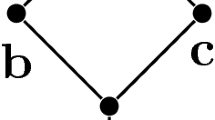Abstract
Every residuated lattice can be considered as an idempotent semiring. Conversely, if an idempotent semiring is finite, then it can be organized into a residuated lattice. Unfortunately, this does not hold in general. We show that if an idempotent semiring is equipped with an involution which satisfies certain conditions, then it can be organized into a residuated lattice satisfying the double negation law. Also conversely, every residuated lattice satisfying the double negation law can be considered as an idempotent semiring with an involution satisfying the mentioned conditions.
Similar content being viewed by others
References
Belluce LP, Di Nola A, Ferraioli AR (2013) MV-semirings and their sheaf representation. Order 30:165–179
Bonzio S, Chajda I, Ledda A (2016) Representing quantum structures as near semiring. Logic J IGPL 24(2016):719–742
Cignoli R, D’Ottaviano I, Mundici D (1999) Algebraic foundations of many-valued reasoning. Trends in logic. Kluwer Academic Publishers, Dordrecht, Boston, Heidelberg
Chajda I, Länger H (2015) Commutative basic algebras and coupled near semirings. Soft Comput 19:1129–1134
Chajda I, Länger H (2016) Near semirings and semirings with involution. Miskolc Math Notes 17(2016):801–810
Ciungu LC (2014) Non-commutative Multiple-Valued Logic Algebras. Springer Verlag, Heidelberg, New York, Dordrecht, ISBN 978-3-319-01588-0
Galatos N, Jipsen P, Kowalski T, Ono H (2007) Residuated lattices: An algebraic glimpse at substructural logic. Elsevier, Amsterdam, Boston, Dordrecht
Gispert J (2003) Axiomatic extensions of nilpotent minimum logic. Rep Math Log 37:113–123
Golan JS (1992) The theory of semirings with applications in mathematics and theoretical computer science. Wiley, New York
Hájek P (1998) Mathematics of fuzzy logic, trends in logic. Kluwer Academic Publishers, Dordrecht, Boston, London
Kuich W, Salomaa A (1986) Semirings, automata, languages. Springer, Berlin
Rachůnek J, Svoboda Z (2014) Interior and closure operators on bounded residuated lattices. Cent Eur J Math 12:534–544
Acknowledgements
The research of the author is supported by the project IGA PrF 2017012 Palacky University Olomouc and by the Austrian Science Fund (FWF), Project I 1923-N25, and the Czech Science Foundation (GAR): Project 15-34697L.
Author information
Authors and Affiliations
Corresponding author
Ethics declarations
Conflict of interest
The author declares that there is no conflict of interest.
Ethical approval
This article does not contain any studies with human participants or animals performed by any of the authors.
Additional information
Communicated by A. Di Nola.
Rights and permissions
About this article
Cite this article
Chajda, I. A representation of residuated lattices satisfying the double negation law. Soft Comput 22, 1773–1776 (2018). https://doi.org/10.1007/s00500-017-2673-9
Published:
Issue Date:
DOI: https://doi.org/10.1007/s00500-017-2673-9



